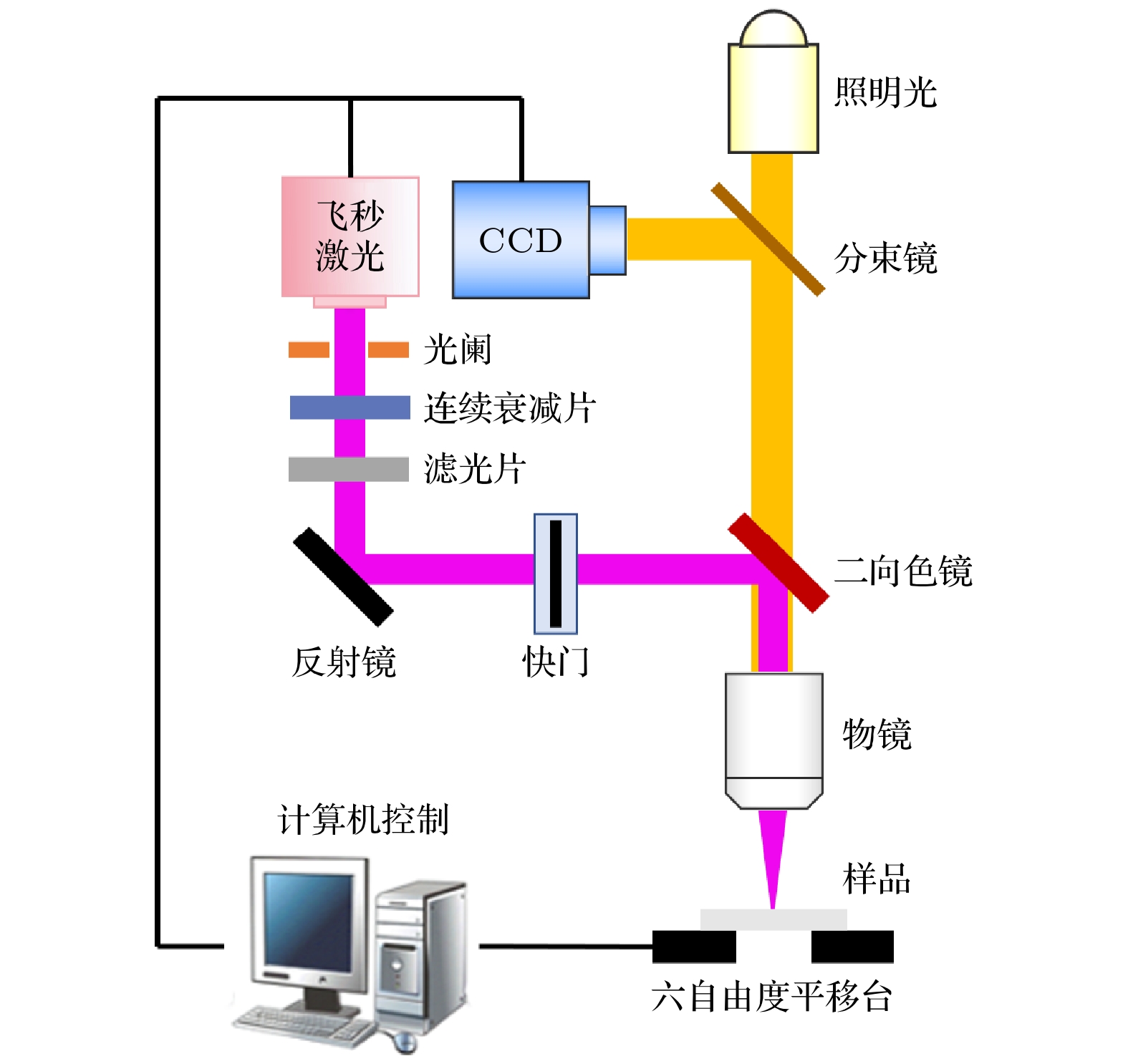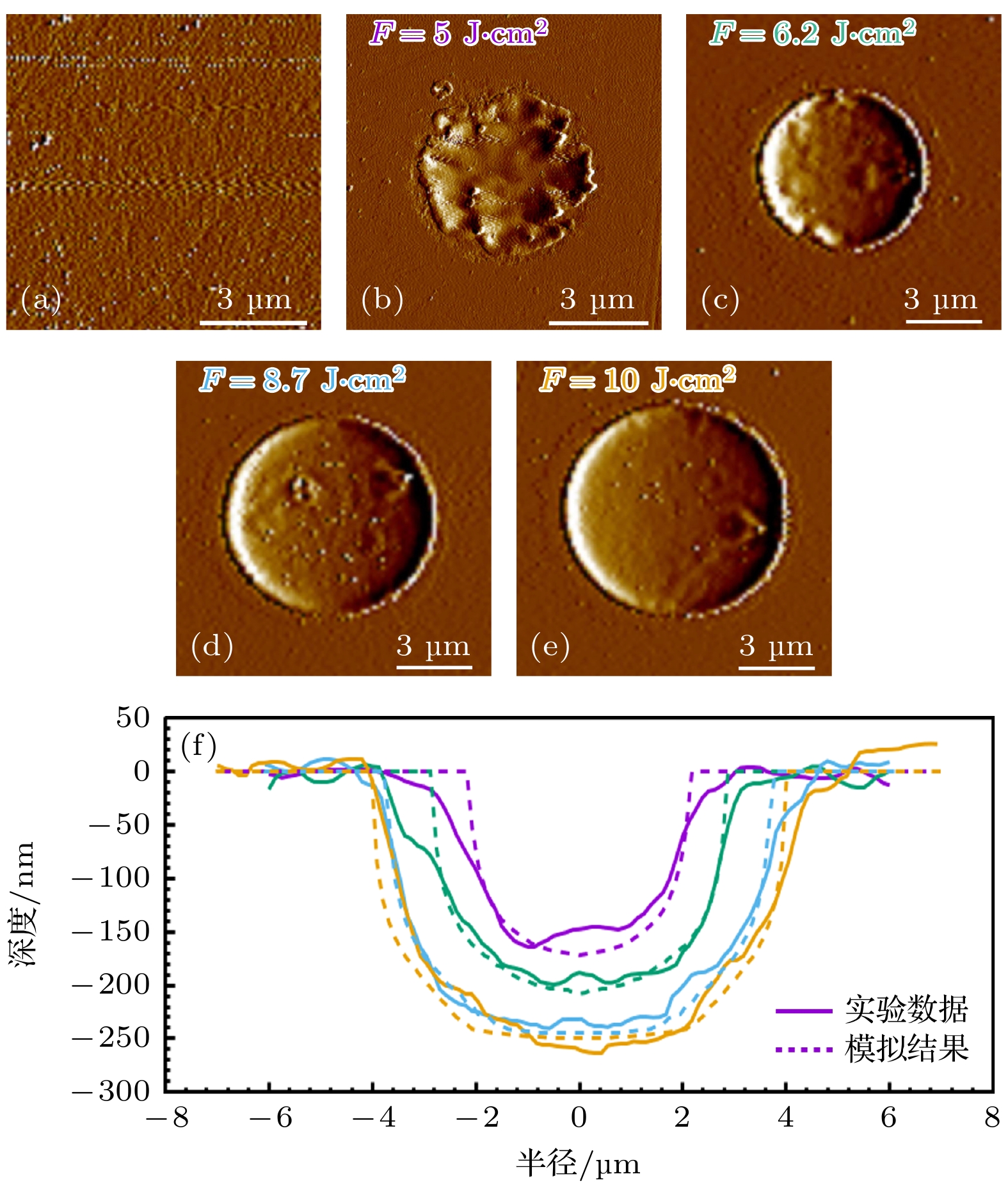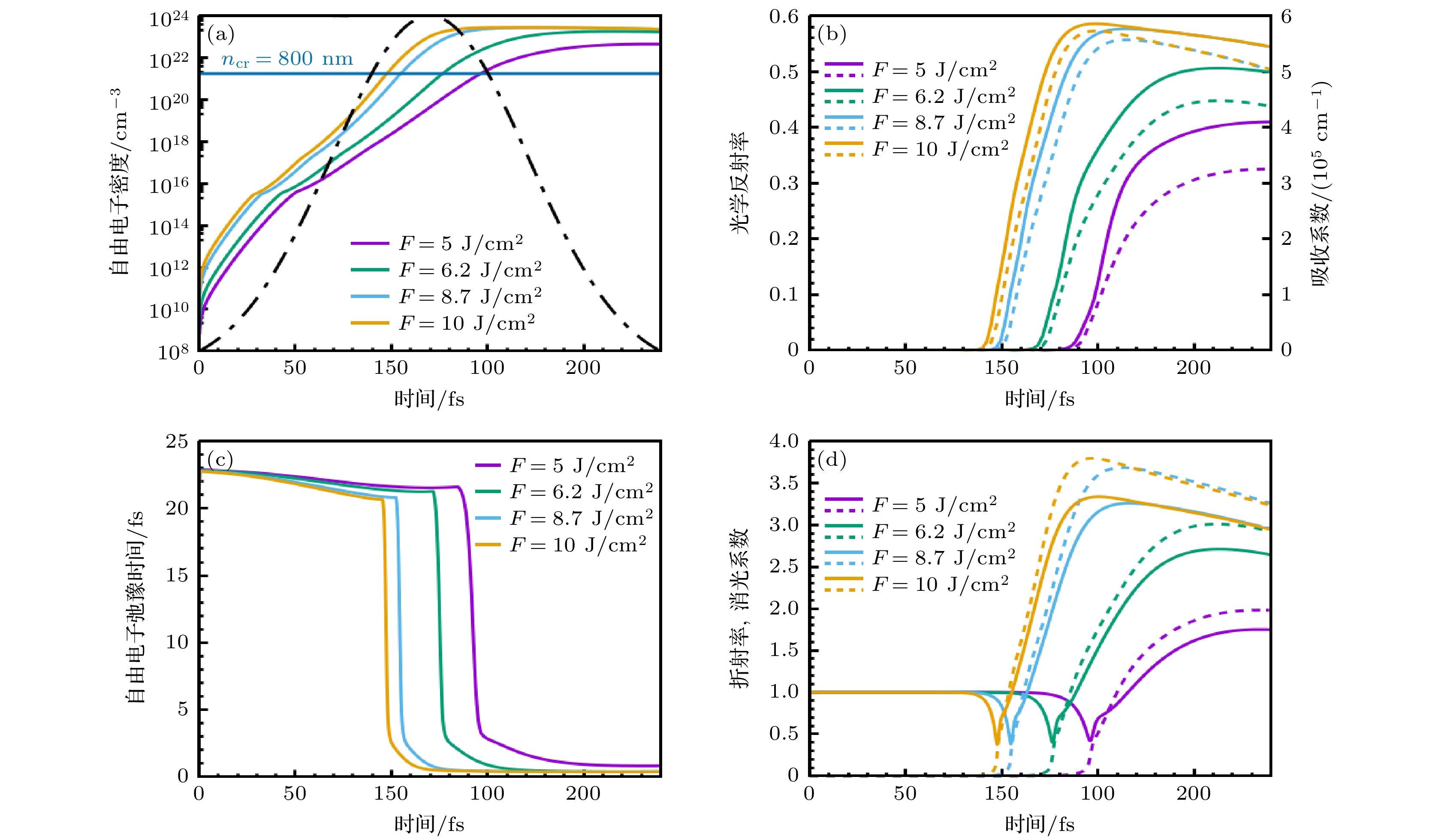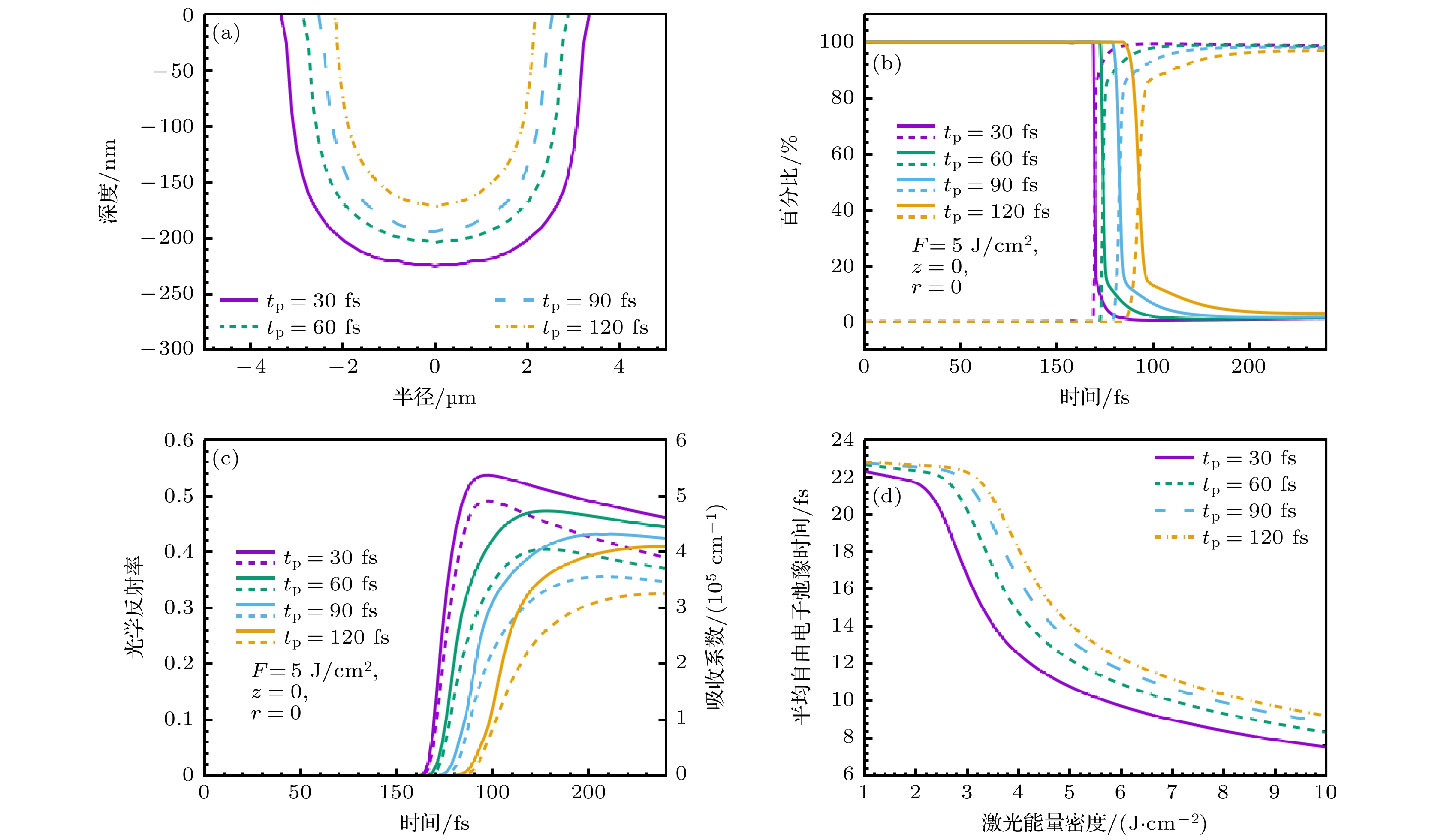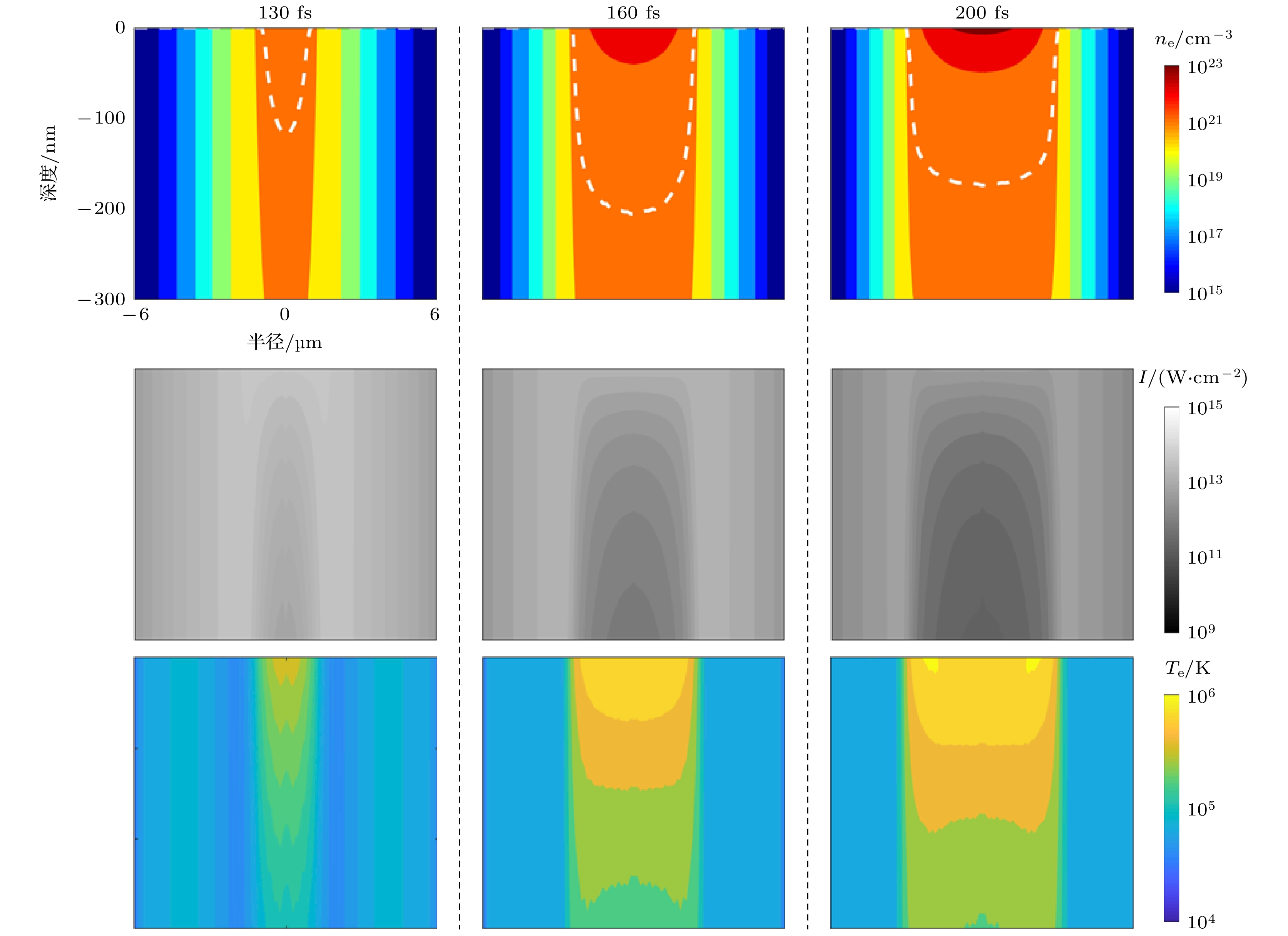-
The ablation threshold, depth and crater shape of fused silica for femtosecond laser processing are investigated theoretically and experimentally. Based on tracking the spatiotemporal distribution of the free electron density, free electron temperature, and laser intensity, the electron dynamics as well as the transient optical and thermophysical properties of femtosecond laser irradiated fused silica are quantitatively determined. The numerical model is validated by comparing the calculated threshold fluence, depth and crater shape of ablation with the experimentally measured ones at a wavelength of 800 nm. The free electron relaxation time at different laser fluences and pulse durations throughout the photoionization process and impact ionization process are probed. In the present work, the findings are as follows. 1) The electron relaxation time significantly affects the material optical properties and femtosecond laser energy absorption. The optical properties change dramatically. The fused silica becomes opaque for the case of laser irradiation with fluence higher than the ablation threshold. Moreover, the transition from electron-phonon collision to electron-ion collision accompanies with the femtosecond laser ablation of fused silica. 2) By using the proposed model, the experimentally observed saturation of ablation depth at high laser fluence is elucidated by the significant change of optical reflectivity and absorption coefficient. Both the results of theoretical simulation and experimental observation indicate that laser fluence has a strong influence on the shape of the ablation crater. The ablation volume increases sharply with the increase of laser fluence for femtosecond laser irradiation, compared with that for picosecond laser irradiation. 3) With the increase of femtosecond laser fluence, the ablation depth removal efficiency and ablation efficiency are both saturated, followed by slight decrements. The peak of ablation depth removal efficiency peak occurs at the femtosecond laser fluence close to 1.4 times of the ablation threshold. While the accuracy is slightly low due to the higher sensitivity of the ablation characteristics (ablation crater depth and ablation volume) to the shorter femtosecond laser pulse. For the femtosecond laser fluence higher than 3.5 times of the ablation threshold, good repeatability over a very wide fluence range can achieve accurate processing results, because a more consistent flat-bottom ablation profile tends to appear. However, the heat-affected zone leads the processing quality to degrade, compared with the scenario of femtosecond laser fluence close to the ablation threshold.
-
Keywords:
- femtosecond laser /
- laser-matter interaction /
- dielectrics /
- free electron relaxation time
[1] Jia X, Zhao X 2020 Opt. Lett. 45 3390
 Google Scholar
Google Scholar
[2] Ji P, Zhang Y 2013 J. Phys. D:Appl. Phys. 46 495108
 Google Scholar
Google Scholar
[3] Mouskeftaras A, Guizard S, Fedorov N, Klimentov S 2013 Appl. Phys. A 110 709
 Google Scholar
Google Scholar
[4] Gallais L, Douti D B, Commandré M, Batavičite G, Pupka E, Ščiuka M, Smalakys L, Sirutkaitis V, Melninkaitis A 2015 J. Appl. Phys. 117 223103
 Google Scholar
Google Scholar
[5] Tsai Y H, Chen B C, Ho C Y, Chiou Y J, Chen K H, Chen C S, Wen M Y 2017 Ceram. Int. 43 S573
 Google Scholar
Google Scholar
[6] Ji P, Zhang Y 2017 Appl. Phys. A 123 671
 Google Scholar
Google Scholar
[7] Stoian R, Colombier J P, Mauclair C, Cheng G, Bhuyan M K, Velpula P K, Srisungsitthisunti P 2014 Appl. Phys. A 114 119
 Google Scholar
Google Scholar
[8] Wu C, Fang X, Liu F, Guo X, Maeda R, Jiang Z 2020 Ceram. Int. 46 17896
 Google Scholar
Google Scholar
[9] De Zanet A, Casalegno V, Salvo M 2021 Ceram. Int. 47 7307
 Google Scholar
Google Scholar
[10] Chimier B, Utéza O, Sanner N, Sentis M, Itina T, Lassonde P, Légaré F, Vidal F, Kieffer J C 2011 Phys. Rev. B 84 094104
 Google Scholar
Google Scholar
[11] Lebugle M, Sanner N, Utéza O, Sentis M 2014 Appl. Phys. A 114 129
 Google Scholar
Google Scholar
[12] Terasawa E, Shibuya T, Satoh D, Moriai Y, Ogawa H, Tanaka M, Kuroda R, Kobayashi Y, Sakaue K, Washio M 2020 Appl. Phys. A 126 446
 Google Scholar
Google Scholar
[13] Jiang L, Wang A D, Li B, Cui T H, Lu Y F 2018 Light Sci. Appl. 7 17134
 Google Scholar
Google Scholar
[14] Keldysh L V 1965 Phys. JETP 20 1307
[15] Du D, Liu X, Korn G, Squier J, Mourou G 1994 Appl. Phys. Lett. 64 3071
 Google Scholar
Google Scholar
[16] Stuart B C, Feit M D, Rubenchik A M, Shore B W, Perry M D 1995 Phys. Rev. Lett. 74 2248
 Google Scholar
Google Scholar
[17] Perry M D, Stuart B C, Banks P S, Feit M D, Yanovsky V, Rubenchik A M 1999 J. Appl. Phys. 85 6803
 Google Scholar
Google Scholar
[18] Xu X, Chen G, Song K H 1999 Int. J. Heat Mass Transfer 42 1371
 Google Scholar
Google Scholar
[19] Stoian R, Ashkenasi D, Rosenfeld A, Campbell E E B 2000 Phys. Rev. B 62 13167
 Google Scholar
Google Scholar
[20] Stuart B, Feit M, Herman S, Rubenchik A, Shore B, Perry M 1996 Phys. Rev. B 53 1749
 Google Scholar
Google Scholar
[21] Pronko P P, Van Rompay P A, Horvath C, Liu X, Juhasz T, Mourou G 1998 Phys. Rev. B 58 2387
 Google Scholar
Google Scholar
[22] Tien A C, Backus S, Kapteyn H, Murnane M, Mourou G 1999 Phys. Rev. Lett. 82 3883
 Google Scholar
Google Scholar
[23] Peñano J R, Sprangle P, Hafizi B, Manheimer W, Zigler A 2005 Phys. Rev. E 72 036412
 Google Scholar
Google Scholar
[24] Rogalski M S, Palmer S B 2014 Solid State Physics (London: CRC Press) pp310–351
[25] Rämer A, Haahr-Lillevang L, Rethfeld B, Balling P 2016 Opt. Eng. 56 011015
 Google Scholar
Google Scholar
[26] Martin P, Guizard S, Daguzan P, Petite G, D’Oliveira P, Meynadier P, Perdrix M 1997 Phys. Rev. B 55 5799
 Google Scholar
Google Scholar
[27] Christensen B H, Balling P 2009 Phys. Rev. B 79 155424
 Google Scholar
Google Scholar
[28] Jiang L, Tsai H L 2005 Int. J. Heat Mass Transfer 48 487
 Google Scholar
Google Scholar
[29] Lenzner M, Krüger J, Sartania S, Cheng Z, Spielmann C, Mourou G, Kautek F 1998 Phys. Rev. Lett. 80 4076
 Google Scholar
Google Scholar
[30] Utéza O, Sanner N, Chimier B, Brocas A, Varkentina N, Sentis M, Lassonde P, Légaré F, Kieffer J C 2011 Appl. Phys. A 105 131
 Google Scholar
Google Scholar
[31] Audebert P, Daguzan P, Santos A Dos, Gauthier J C, Geindre J P, Guizard S, Hamoniaux G, Krastev K, Martin P, Petite G, Antonetti A 1994 Phys. Rev. Lett. 73 1990
 Google Scholar
Google Scholar
[32] Gamaly E G, Juodkazis S, Nishimura K, Misawa H, Luther-Davies B, Hallo L, Nicolai P, Tikhonchuk V T 2006 Phys. Rev. B 73 214101
 Google Scholar
Google Scholar
[33] Garcia-Lechuga M, Haahr-Lillevang L, Siegel J, Balling P, Guizard S, Solis J 2017 Phys. Rev. B 95 214114
 Google Scholar
Google Scholar
[34] Fukuhara M, Sanpei A, Shibuki K 1997 J. Mater. Sci. 32 1207
 Google Scholar
Google Scholar
[35] Wædegaard K, Frislev M, Balling P 2013 Appl. Phys. A 110 601
 Google Scholar
Google Scholar
[36] Yuan Y, Jiang L, Li X, Wang C, Yuan L, Qu L, Lu Y 2013 Appl. Opt. 52 4035
 Google Scholar
Google Scholar
[37] Bourgeade A, Mézel C, Saut O 2010 J. Sci. Comput. 44 170
 Google Scholar
Google Scholar
[38] Pan C, Jiang L, Sun J, Wang Q, Wang F, Wang K, Lu Y, Wang Y, Qu L, Cui T 2020 Light Sci. Appl. 9 80
 Google Scholar
Google Scholar
[39] Key M H 1989 The Physics of Laser Plasma Interactions (Wokingham: Addison-Wesley) pp417−420
[40] Walker F E 1988 Appl. Phys. 63 5548
 Google Scholar
Google Scholar
[41] Eidmann K, Meyer-Ter-Vehn J, Schlegel T, Hüller S 2000 Phys. Rev. E 62 1202
 Google Scholar
Google Scholar
[42] Rethfeld B 2004 Phys. Rev. Lett. 92 187401
 Google Scholar
Google Scholar
[43] Gamaly E G, Rode A V, Luther-Davies B, Tikhonchuk V T 2002 Phys. Plasmas 9 949
 Google Scholar
Google Scholar
[44] Jia X, Zhao X 2019 Appl. Surf. Sci. 463 781
 Google Scholar
Google Scholar
[45] Rohlf J W 1994 Modern Physics from α to Z0 (New York: Wiley) pp350−352
[46] Liu J M 1982 Opt. Lett. 7 196
 Google Scholar
Google Scholar
[47] Mirza I, Bulgakova N M, Tomáštík J, Michálek V, Haderka O, Fekete L, Mocek T 2016 Sci. Rep. 6 39133
 Google Scholar
Google Scholar
[48] Zakharov A S, Volkov M V, Gurov I P, Temnov V V, Sokolovski-Tinten K, von der Linde D 2002 J. Opt. Technol. 69 478
 Google Scholar
Google Scholar
[49] Arnold D, Cartier E, DiMaria D J 1994 Phys. Rev. B 49 10278
 Google Scholar
Google Scholar
[50] Arnold D, Cartier E, Dimaria D J 1992 Phys. Rev. B 45 1477
 Google Scholar
Google Scholar
[51] Pasquier C, Sentis M, Utéza O, Sanner N 2016 Laser Appl. Microelectron. Optoelectron. Manuf. XXI 9735 97350H
[52] Chichkov B N, Korte F, Koch J, Nolte S, Ostendorf A 2002 High-Power Laser Ablation IV 4760 19
 Google Scholar
Google Scholar
[53] Haahr-Lillevang L, Wædegaard K, Sandkamm D B, Mouskeftaras A, Guizard S, Balling P 2015 Appl. Phys. A 120 1221
 Google Scholar
Google Scholar
-
图 3 (a) 给定脉冲持续时间的烧蚀阈值与实验结果对比, 其中深蓝色三角形、绿色误差条、蓝色空心矩形和橙色空心三角形分别来自本研究的实验结果以及文献[29, 22, 10]; (b) 在脉冲持续时间为
$ 120 $ 和$ 300\rm{ }\rm{f}\rm{s} $ 时, 烧蚀深度作为激光能量密度的函数, 其中深蓝色三角形、红色空心圆形分别来自本研究的实验结果、文献[30]Figure 3. (a) Threshold fluence at the given pulse duration in comparison with experimental results. The navy-blue triangle, green error bar, blue unfilled square, and orange unfilled triangle come from the present study, Refs. [29, 22, 10], respectively; (b) the ablation depth as a function of laser fluence for the cases with pulse duration of
$ 120 $ and$ 300\rm{ }\rm{f}\rm{s} $ . The navy-blue triangle and red unfilled circular come from the present study and Ref. [30], respectively.图 5 脉冲持续时间
${t}_{\rm{p}}=120\;\rm{f}\rm{s}$ , 激光能量密度$ F=5, 6.2, 8.7 $ 和$ 10\rm{ }\rm{J}/{\rm{c}\rm{m}}^{2} $ 时, (a) 自由电子密度、(b) 光学特性(光学反射率(实线)和吸收系数(虚线))、(c) 自由电子弛豫时间、(d) 折射率(实线)和消光系数(虚线)在$ r=0 $ ,$ z=0 $ 处的时间演化Figure 5. Temporal evolution of (a) free electron density, (b) optical properties (optical reflectivity (solid lines) and absorption coefficient (dash lines)), (c) free electron relaxation time, and (d) refractive index (solid lines) and extinction coefficient (dash lines) at
$ r=0 $ ,$ z=0 $ , with${t}_{\rm{p}}=120\;\rm{f}\rm{s}$ and$ F=5 $ ,$ 6.2 $ ,$ 8.7 $ and$ 10\rm{ }\rm{J}/{\rm{c}\rm{m}}^{2} $ .图 6 不同激光脉冲持续时间(
$ F=5\rm{ }\rm{J}/{\rm{c}\rm{m}}^{2} $ )下模拟得到的(a) 烧蚀坑形状、(b) 电子-声子碰撞(实线)和电子-离子碰撞(虚线)的效果百分比的时间演变、(c) 反射率(实线)和吸收系数(虚线)的时间演变, 以及(d) 不同能量密度下的平均自由电子弛豫时间Figure 6. (a) Ablation crater shape, (b) temporal evolution of effective occupation of electron-phonon collision (solid line) and electron-ion collision (dashed line), (c) temporal evolution of optical reflectivity (solid line) and absorption coefficient (dashed line) for different laser pulse durations (
$ F=5\rm{ }\rm{J}/{\rm{c}\rm{m}}^{2} $ ). (d) Average free electron relaxation time at different fluences.图 7 (a) 不同脉冲持续时间下烧蚀体积与激光能量密度的关系. 计算结果用点表示并进行线性拟合; (b) 不同脉冲持续时间下深度去除效率和烧蚀效率与激光能量密度的关系
Figure 7. (a) Ablation volume as a function of laser fluence for different pulse durations. The calculated results are expressed by points and linear fitted in terms of the solid lines. (b) The depth removal efficiency and ablation efficiency as a function of laser fluence for different pulse durations.
图 8 脉冲持续时间
${t}_{\rm{p}}=120\;\rm{f}\rm{s}$ 、激光能量密度$ F=6.2\rm{ }\rm{J}/{\rm{c}\rm{m}}^{2} $ 时, (a) 材料表面上的光学反射率和(b)光束中心处$ z $ 方向上的光学透射深度的时空演化Figure 8. Spatiotemporal evolution of (a) optical reflectivity on the material surface (
$ z=0 $ ) and (b) penetration depth in the z-axis direction ($ r=0 $ ) with${t}_{\rm{p}}=120\;\rm{f}\rm{s}$ and$ F=6.2\rm{ }\rm{J}/{\rm{c}\rm{m}}^{2} $ .图 9 脉冲持续时间
${t}_{\rm{p}}=120\;\rm{f}\rm{s}$ 、激光能量密度$F=6.2\;\rm{J}/{\rm{c}\rm{m}}^{2}$ 时, 自由电子密度$ {n}_{\rm{e}} $ 、激光强度$ I $ 和电子温度$ {T}_{\rm{e}} $ 的时空分布. 白色虚线表示$ {n}_{\rm{e}}={n}_{\rm{c}\rm{r}} $ 的位置Figure 9. Spatiotemporal distributions of free electron density
$ {n}_{\rm{e}} $ , laser intensity$ I $ and free electron temperature$ {T}_{\rm{e}} $ with${t}_{\rm{p}}=120\;\rm{f}\rm{s}$ and$F=6.2\;\rm{J}/{\rm{c}\rm{m}}^{2}$ . The white dashed lines locate where$ {n}_{\rm{e}}={n}_{\rm{c}\rm{r}} $ .表 1 模型中用到的常数
Table 1. Constants used in the model.
符号 描述 数值 单位 $ {n}_{0} $ 初始电子密度 $ 1\times {10}^{8} $[22] $ {\rm{c}\rm{m}}^{-3} $ $ {n}_{\rm{v}0} $ 总电子密度 $ 3\times {10}^{23} $[32] $ {\rm{c}\rm{m}}^{-3} $ $ {\tau }_{\rm{r}} $ 衰减时间常数 $ 150 $[31] $ \rm{f}\rm{s} $ $ U $ 带隙能量 $ 9 $ $ \rm{e}\rm{V} $ $ {T}_{\rm{D}} $ 德拜温度 $ 364 $[34] $ \rm{K} $ $ {T}_{\rm{l}} $ 晶格温度 $ 300 $ $ \rm{K} $ $ \lambda $ 激光波长 $ 800 $ $ \rm{n}\rm{m} $ -
[1] Jia X, Zhao X 2020 Opt. Lett. 45 3390
 Google Scholar
Google Scholar
[2] Ji P, Zhang Y 2013 J. Phys. D:Appl. Phys. 46 495108
 Google Scholar
Google Scholar
[3] Mouskeftaras A, Guizard S, Fedorov N, Klimentov S 2013 Appl. Phys. A 110 709
 Google Scholar
Google Scholar
[4] Gallais L, Douti D B, Commandré M, Batavičite G, Pupka E, Ščiuka M, Smalakys L, Sirutkaitis V, Melninkaitis A 2015 J. Appl. Phys. 117 223103
 Google Scholar
Google Scholar
[5] Tsai Y H, Chen B C, Ho C Y, Chiou Y J, Chen K H, Chen C S, Wen M Y 2017 Ceram. Int. 43 S573
 Google Scholar
Google Scholar
[6] Ji P, Zhang Y 2017 Appl. Phys. A 123 671
 Google Scholar
Google Scholar
[7] Stoian R, Colombier J P, Mauclair C, Cheng G, Bhuyan M K, Velpula P K, Srisungsitthisunti P 2014 Appl. Phys. A 114 119
 Google Scholar
Google Scholar
[8] Wu C, Fang X, Liu F, Guo X, Maeda R, Jiang Z 2020 Ceram. Int. 46 17896
 Google Scholar
Google Scholar
[9] De Zanet A, Casalegno V, Salvo M 2021 Ceram. Int. 47 7307
 Google Scholar
Google Scholar
[10] Chimier B, Utéza O, Sanner N, Sentis M, Itina T, Lassonde P, Légaré F, Vidal F, Kieffer J C 2011 Phys. Rev. B 84 094104
 Google Scholar
Google Scholar
[11] Lebugle M, Sanner N, Utéza O, Sentis M 2014 Appl. Phys. A 114 129
 Google Scholar
Google Scholar
[12] Terasawa E, Shibuya T, Satoh D, Moriai Y, Ogawa H, Tanaka M, Kuroda R, Kobayashi Y, Sakaue K, Washio M 2020 Appl. Phys. A 126 446
 Google Scholar
Google Scholar
[13] Jiang L, Wang A D, Li B, Cui T H, Lu Y F 2018 Light Sci. Appl. 7 17134
 Google Scholar
Google Scholar
[14] Keldysh L V 1965 Phys. JETP 20 1307
[15] Du D, Liu X, Korn G, Squier J, Mourou G 1994 Appl. Phys. Lett. 64 3071
 Google Scholar
Google Scholar
[16] Stuart B C, Feit M D, Rubenchik A M, Shore B W, Perry M D 1995 Phys. Rev. Lett. 74 2248
 Google Scholar
Google Scholar
[17] Perry M D, Stuart B C, Banks P S, Feit M D, Yanovsky V, Rubenchik A M 1999 J. Appl. Phys. 85 6803
 Google Scholar
Google Scholar
[18] Xu X, Chen G, Song K H 1999 Int. J. Heat Mass Transfer 42 1371
 Google Scholar
Google Scholar
[19] Stoian R, Ashkenasi D, Rosenfeld A, Campbell E E B 2000 Phys. Rev. B 62 13167
 Google Scholar
Google Scholar
[20] Stuart B, Feit M, Herman S, Rubenchik A, Shore B, Perry M 1996 Phys. Rev. B 53 1749
 Google Scholar
Google Scholar
[21] Pronko P P, Van Rompay P A, Horvath C, Liu X, Juhasz T, Mourou G 1998 Phys. Rev. B 58 2387
 Google Scholar
Google Scholar
[22] Tien A C, Backus S, Kapteyn H, Murnane M, Mourou G 1999 Phys. Rev. Lett. 82 3883
 Google Scholar
Google Scholar
[23] Peñano J R, Sprangle P, Hafizi B, Manheimer W, Zigler A 2005 Phys. Rev. E 72 036412
 Google Scholar
Google Scholar
[24] Rogalski M S, Palmer S B 2014 Solid State Physics (London: CRC Press) pp310–351
[25] Rämer A, Haahr-Lillevang L, Rethfeld B, Balling P 2016 Opt. Eng. 56 011015
 Google Scholar
Google Scholar
[26] Martin P, Guizard S, Daguzan P, Petite G, D’Oliveira P, Meynadier P, Perdrix M 1997 Phys. Rev. B 55 5799
 Google Scholar
Google Scholar
[27] Christensen B H, Balling P 2009 Phys. Rev. B 79 155424
 Google Scholar
Google Scholar
[28] Jiang L, Tsai H L 2005 Int. J. Heat Mass Transfer 48 487
 Google Scholar
Google Scholar
[29] Lenzner M, Krüger J, Sartania S, Cheng Z, Spielmann C, Mourou G, Kautek F 1998 Phys. Rev. Lett. 80 4076
 Google Scholar
Google Scholar
[30] Utéza O, Sanner N, Chimier B, Brocas A, Varkentina N, Sentis M, Lassonde P, Légaré F, Kieffer J C 2011 Appl. Phys. A 105 131
 Google Scholar
Google Scholar
[31] Audebert P, Daguzan P, Santos A Dos, Gauthier J C, Geindre J P, Guizard S, Hamoniaux G, Krastev K, Martin P, Petite G, Antonetti A 1994 Phys. Rev. Lett. 73 1990
 Google Scholar
Google Scholar
[32] Gamaly E G, Juodkazis S, Nishimura K, Misawa H, Luther-Davies B, Hallo L, Nicolai P, Tikhonchuk V T 2006 Phys. Rev. B 73 214101
 Google Scholar
Google Scholar
[33] Garcia-Lechuga M, Haahr-Lillevang L, Siegel J, Balling P, Guizard S, Solis J 2017 Phys. Rev. B 95 214114
 Google Scholar
Google Scholar
[34] Fukuhara M, Sanpei A, Shibuki K 1997 J. Mater. Sci. 32 1207
 Google Scholar
Google Scholar
[35] Wædegaard K, Frislev M, Balling P 2013 Appl. Phys. A 110 601
 Google Scholar
Google Scholar
[36] Yuan Y, Jiang L, Li X, Wang C, Yuan L, Qu L, Lu Y 2013 Appl. Opt. 52 4035
 Google Scholar
Google Scholar
[37] Bourgeade A, Mézel C, Saut O 2010 J. Sci. Comput. 44 170
 Google Scholar
Google Scholar
[38] Pan C, Jiang L, Sun J, Wang Q, Wang F, Wang K, Lu Y, Wang Y, Qu L, Cui T 2020 Light Sci. Appl. 9 80
 Google Scholar
Google Scholar
[39] Key M H 1989 The Physics of Laser Plasma Interactions (Wokingham: Addison-Wesley) pp417−420
[40] Walker F E 1988 Appl. Phys. 63 5548
 Google Scholar
Google Scholar
[41] Eidmann K, Meyer-Ter-Vehn J, Schlegel T, Hüller S 2000 Phys. Rev. E 62 1202
 Google Scholar
Google Scholar
[42] Rethfeld B 2004 Phys. Rev. Lett. 92 187401
 Google Scholar
Google Scholar
[43] Gamaly E G, Rode A V, Luther-Davies B, Tikhonchuk V T 2002 Phys. Plasmas 9 949
 Google Scholar
Google Scholar
[44] Jia X, Zhao X 2019 Appl. Surf. Sci. 463 781
 Google Scholar
Google Scholar
[45] Rohlf J W 1994 Modern Physics from α to Z0 (New York: Wiley) pp350−352
[46] Liu J M 1982 Opt. Lett. 7 196
 Google Scholar
Google Scholar
[47] Mirza I, Bulgakova N M, Tomáštík J, Michálek V, Haderka O, Fekete L, Mocek T 2016 Sci. Rep. 6 39133
 Google Scholar
Google Scholar
[48] Zakharov A S, Volkov M V, Gurov I P, Temnov V V, Sokolovski-Tinten K, von der Linde D 2002 J. Opt. Technol. 69 478
 Google Scholar
Google Scholar
[49] Arnold D, Cartier E, DiMaria D J 1994 Phys. Rev. B 49 10278
 Google Scholar
Google Scholar
[50] Arnold D, Cartier E, Dimaria D J 1992 Phys. Rev. B 45 1477
 Google Scholar
Google Scholar
[51] Pasquier C, Sentis M, Utéza O, Sanner N 2016 Laser Appl. Microelectron. Optoelectron. Manuf. XXI 9735 97350H
[52] Chichkov B N, Korte F, Koch J, Nolte S, Ostendorf A 2002 High-Power Laser Ablation IV 4760 19
 Google Scholar
Google Scholar
[53] Haahr-Lillevang L, Wædegaard K, Sandkamm D B, Mouskeftaras A, Guizard S, Balling P 2015 Appl. Phys. A 120 1221
 Google Scholar
Google Scholar
Catalog
Metrics
- Abstract views: 9905
- PDF Downloads: 268
- Cited By: 0














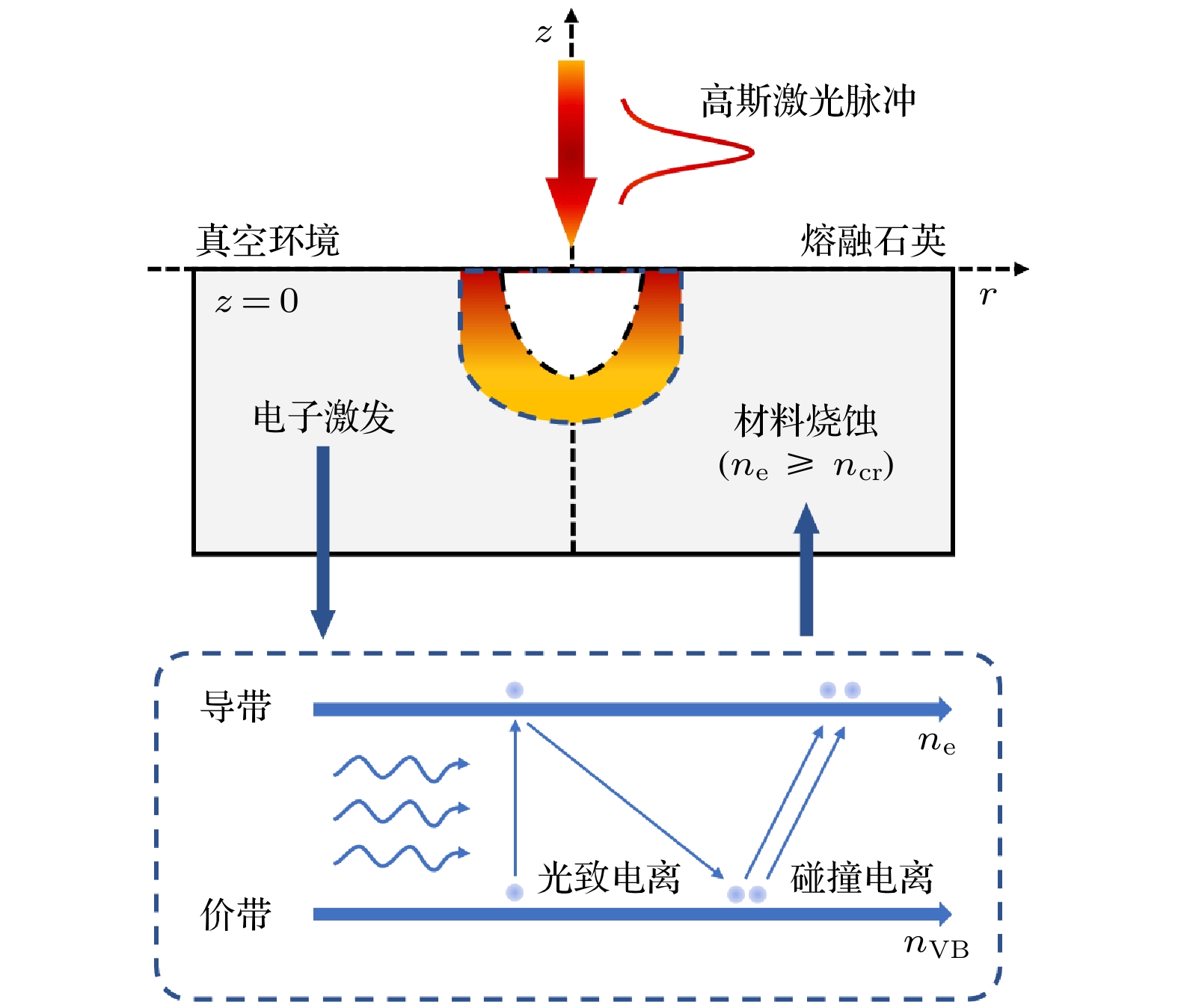
 DownLoad:
DownLoad:
